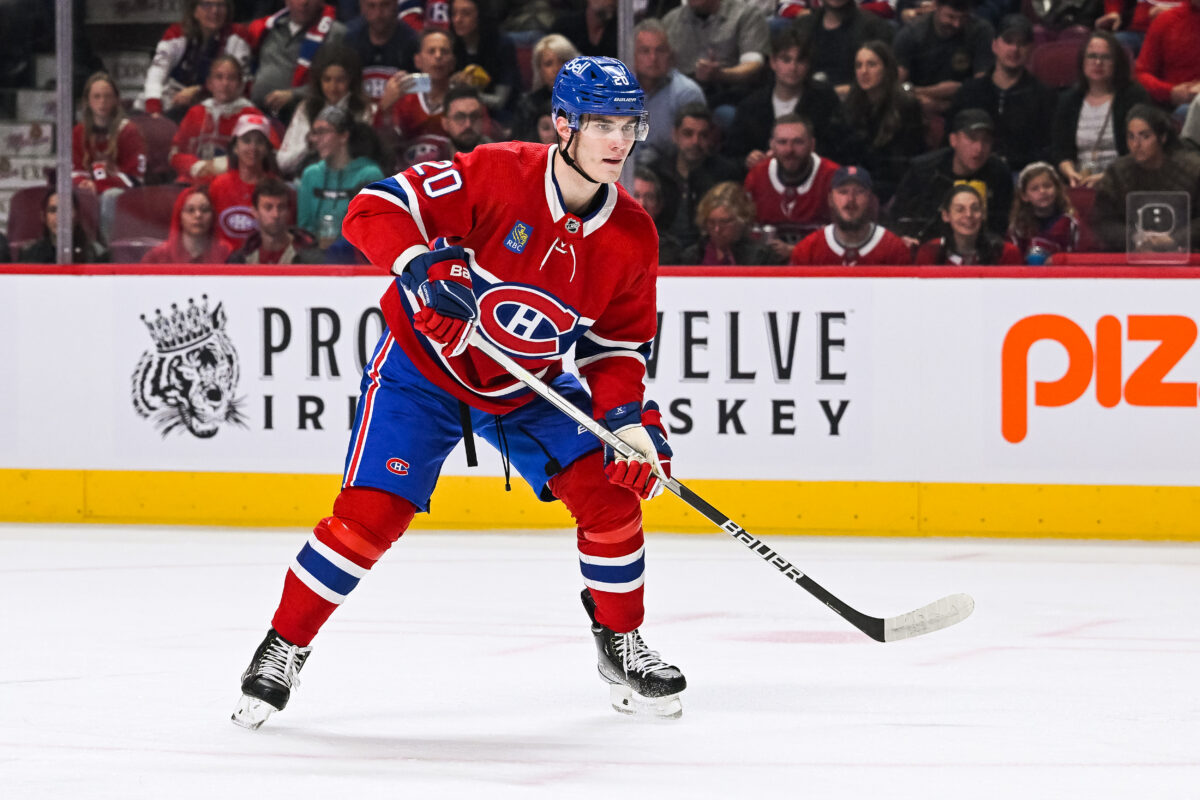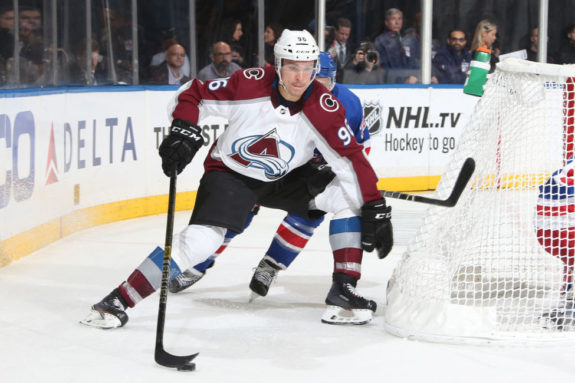To say that Juraj Slafkovsky was a bit of a surprise selection by the Montreal Canadiens as the first overall pick at the 2022 NHL Entry Draft being hosted in Montreal would not be wrong. His size, physical strength, and confidence from his experience against men in his draft year made him the best prepared to take on an NHL role. In looking at his peers this year only five draftees played one game or more in the NHL, which points to the fact the 2022 Draft class was raw and needed more time to develop. Was it because this class was inferior to past draft years, or because they lost significant development time due to a large number of games and even whole seasons being canceled due to the COVID-19 pandemic? Only time can tell, which is why patience will be needed.
Slafkovsky worked diligently over the season to earn more ice time and was placed in more prominent roles before his season-ending injury in January. His four goals and 10 points in 39 games weren’t exactly the production of an instant superstar, which could point to why some were disappointed in his play, even though he is just 18 years old and only celebrated his 19th birthday this past March 30.

Fans tend to forget that the NHL isn’t a league for 18-year-olds. Unfortunately, the expectations placed on a first overall are compared to players like Sidney Crosby and Connor McDavid, not against those from his own draft class such as Shane Wright. Slafkovsky has had some benefits from playing in the NHL and has made positive strides in his game. But he does have several areas that need to be worked on.
Canadiens’ Development Approach
A lower-body injury halted Slafkovsky’s season, on top of that his limited ice time and lack of power play opportunities made it hard for him to put much of a dent into the scoresheet. While the rookie didn’t get to accomplish everything he could have hoped to, it wasn’t a lost season as he did grow his game.
Size
Something that cannot be taught is size, which the 6-foot-3, 238-pound winger has. How to use that size is also a skill, and in his case, one that he is already confident in using. Playing against NHL players isn’t easy, especially at 18 years old as their speed and size are something that takes time to adjust to playing against. Slafkovsky didn’t need time to adjust, frequently winning his one-on-one battles. More importantly he “played between the dots”, meaning he was a consistent threat attacking the slot and the front of the net, an aspect of the game the Canadiens have needed for years.
Skating
Before his draft, there were concerns about his skating. He lacked footspeed and even some mobility, which could cause issues when trying to play a cycle game or gain possession of the puck and then make quick cuts to attack the net. However, in only half a season under the tutelage of Player Development Director Adam Nicholas, there was a clear improvement as he has added speed and is improving in several other areas, including spacial awareness.
These drills, among others, are designed to instill the habits he will need to become instinctual to put his talents to use and meet his full potential. Slafkovsky still projects as a star winger as he can set up or finish plays, and his compete level makes him a player who will be hard to beat once he brings all his tools together. His penchant for playing down low, paired with his size, will be his best weapon. He takes most of his shots in tight to the net. The cycle is an area he can dominate, demonstrating an ability to not only get pucks to the net but also make quality passes from the boards and into the slot.
Related: Canadiens’ 2022-23 Season Can Still Be Viewed as a Success
He does have difficulty shooting from long range as he still takes too long to set himself. His shot release also needs to be quicker. When he does release quickly at a distance, his accuracy is negatively affected. Defensively he has the size and reach to fill passing lanes and cover his area effectively. He has shown improvement in his stick placement and gap control but needs to become more comfortable playing at the NHL’s pace to be efficient in this area.
Future Expectations
Slafkovsky’s game translated immediately to the NHL, proving that he could compete against NHL talent, even as an 18-year-old. A good comparison for Slafkovsky is Mikko Rantanen of the Colorado Avalanche. They have a similar build, and style and were developed by the Liiga program TPS in Finland, where their production was similar. It took Rantanen a few years to become the elite offensive player that he is now. If he can improve his puck protection skills and his ability to move through contact, his skills could begin to shine through as Rantanen’s have.

The first-overall pick in 2022 has been assigned video to study by head coach Martin St. Louis in the hopes of learning from other players, similar to himself. It is a process of taking small steps to improve incrementally.
“Like all young players, he’s realizing how difficult the league is. The more games you play, the more difficult it is because teams are more organized. The details become very important. We want to see improvements in the details, especially without the puck. With Slafkovsky, I want to see quality rather than quantity. But I know quantity can help the quality, so there’s a balancing act.”
Martin St. Louis
Slafkovsky spoke about the video he was assigned by St. Louis, mentioning Rantanen by name as one player who he can learn from stating, “He’s really strong on the puck he doesn’t give it away easy, and he can score and make points and is a great player all over the ice”. Nicholas also had him study Charlie Coyle of the Boston Bruins. Not for his offense, but for the puck protection and ability to play the cycle.
The debate for his development falls to playing in the NHL versus the American Hockey League (AHL). Some would have argued he would have benefited from playing at a lower level, becoming accustomed to the North American rink, and building confidence against lesser competition. But his international and professional experience helped him with his confidence already. He needed to become accustomed to the pace of play in the NHL. Something he was showing signs of doing in flashes until he was injured. Slafkovsky, who only played 39 NHL games this past season, didn’t require surgery for his injury and expects to be ready for the start of the 2023-24 season. The good news was he had returned to the ice before the end of the 2022-23 season.
Those 39 games were not as much as Canadiens management or the fans would have hoped for, but he did learn a lot from the video session, individual training sessions, and the situational play St. Louis placed him into. On the ice, Slafkovsky averaged only 12:13 of ice time per game, one minute of which was on the power play. He had been moved up and down the lineup with various linemates, but his most ice time was on a line with Jake Evans at center and Josh Anderson on right wing. His time on that line saw his biggest steps forward, as he learned to use his physical skills and play a heavier game, especially on the forecheck. Having Anderson on his line provided him with an example of what a power forward must do to be effective. Patience will be a necessity as larger players tend to take longer to develop and reach their potential. Tage Thompson of the Buffalo Sabres is a good example of that.
The debate about Slavkovsky and where he should play in 2023-24 will continue. The Canadiens aren’t stepping into next season ready to compete for a Stanley Cup so the pressure on the young players is still focused on individual development and not team success. This is why allowing him more time at the NHL level with the latitude to make mistakes is still best for the young winger. This was the approach St. Louis took with Cole Caufield, and in his 83 games under his tutelage, he has scored 48 goals.
For those who want Slafkovsky to play in the AHL because they feel he was vulnerable to the physical aspects of the game at the NHL level, they should understand that the AHL’s style of play is far more physical, and still has enforcers and several players who would target the young winger to get themselves noticed for call ups. However, if the goal of sending him to the Laval Rocket is to give him more playing time and a top-line role including on the power play, that would be beneficial as his ice time and role in the NHL has been highly limited. Having said that, as he is still waiver exempt, there is no risk to any plan that has him start on the NHL roster.
The NHL does limit a young player’s ability to experiment, and even on a rebuilding team, there are minimum acceptable levels of defensive responsibility that must be met, placing pressure on those young players. There is an obvious risk of slowing developmental progression in allowing Slafkovsky to develop at the NHL level. This is why the need to assess his needs daily will be essential, yet, due to his experience internationally, allowing him to start his sophomore season in the NHL is a good step for the Canadiens to take. If his development plateaus at any point in the season, only then would he be would be better served in going to Laval.